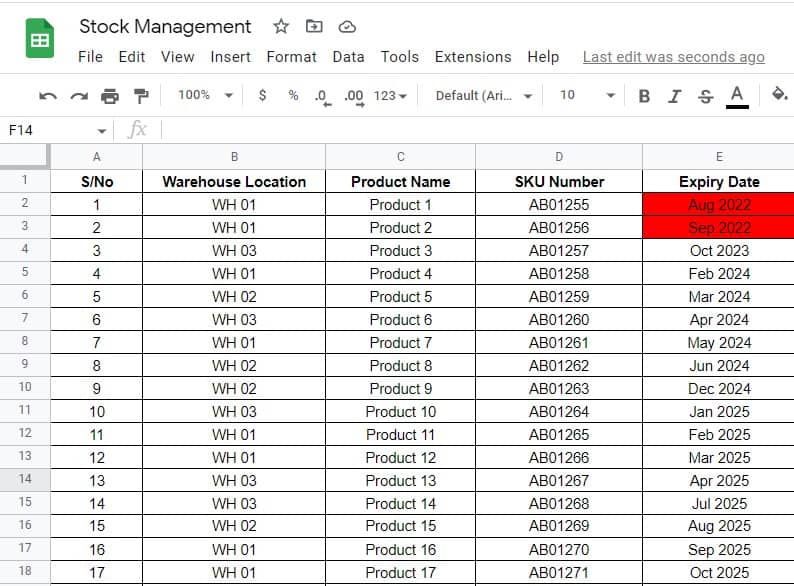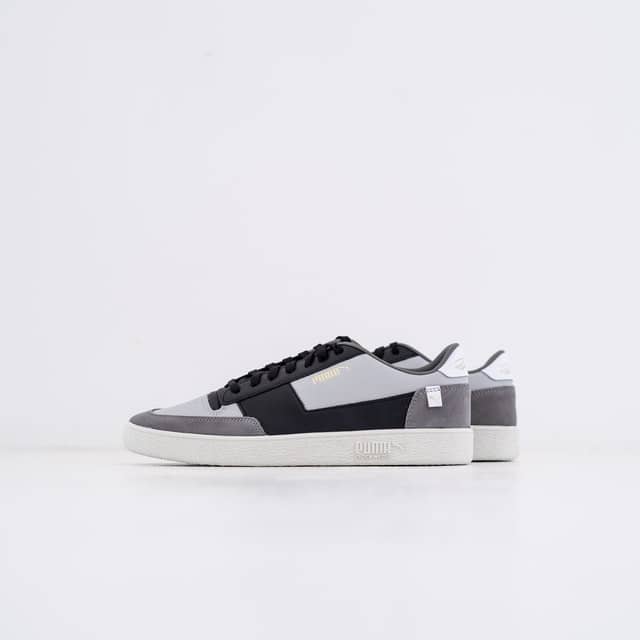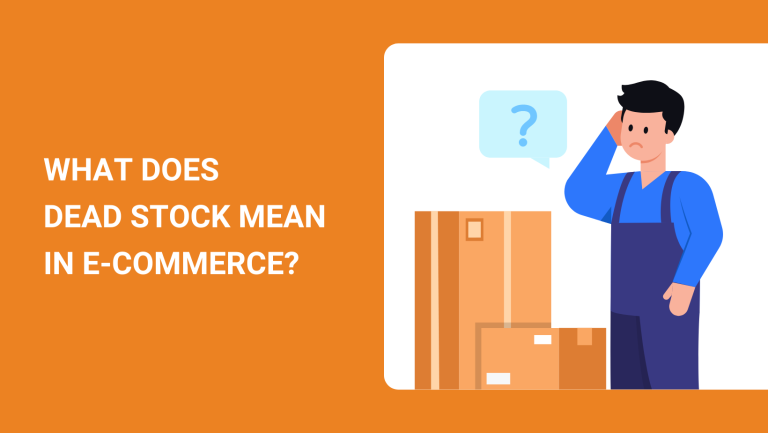Stock liquidation is vital for a business to remain profitable. If half of your stock is selling like crazy and the other half is quite the opposite, the dead stock will start piling up in your warehouse even if the sale figures are good.
But what does dead stock mean in e-commerce and how to deal with it? Are these items of no use to you? Should you get rid of them or do you have any better options?
In this article, we will share all the tips and trickson causes of dead items , how to manage and turn them into profit.
Let’s investigate and learn how to make the dead stock alive again.
What Is Dead Stock?
Dead stock refers to the items or products in your warehouse which were meant for selling but remained unsold and are stuck in your inventory for a longer than expected time.

These items did not attract any sales from the customers even after marketing them through various means. They are also not expected to be sold anytime soon.
It is also termed excess stock or excess inventory that a business is no longer selling either due to closure of that business section or a change of niche.
In short, the dead stock is a nightmare for an e-commerce seller especially if it is in large quantities.
The following factors contribute to the dead stock:
- You have already manufactured or bought these items to be sold.
- You have tried but are unsuccessful in selling them.
- You are bearing costs to keep them in your inventory.
- It is unclear when they will be sold.
Types of Dead Stock
The dead stock is not limited to the items that remained unsold for the first time. It also includes the wrong or defective items in your stock or the items that have been returned by your customers.
Following are the common types of dead stock.
Wrong Items
These are the items that you either purchased by mistake or the products that are different from your niche.
Suppose you have an online store where you sell mobile accessories but you have items in your stock related to home decor.
It may be because you were running a general store before and now you switched to selling mobile accessories only.
Defective Items
These are the items that have defects from the manufacturer.
Sometimes, you receive defective pieces right from your supplier. You may even have agreed on a settlement (refund or half payment, etc.) with your supplier about those items but they still remain in your inventory.
These items also contribute to the dead stock.
Damaged Items
Some items get damaged during transit. They might be damaged either from your supplier or by your warehouse staff during operations.

Items with minor and major damages are included in the list of dead stock.
Returned Items
These are the items that your customers return for various reasons. They may not be as described or your customers might have returned due to any other reason (wrong size, color, functionality, etc).
As returned items, they are probably stored in your inventory and are counted in the dead stock if they are not resold to other customers.
Dead Stock vs Slow-Moving Stock
You may have some items that have a long selling cycle. It may take months for you to receive orders for those products. They are slow-moving goods.
Slow-moving goods are not included in the dead stock because they do have sales and to some extent, you can also forecast when you will get rid of those items keeping their sales cycle in mind.
For example, seasonal items would be considered slow-moving items if you do the annual sales analysis. The summer items would attract sales after a year.
So, they won’t be considered dead stock as their sales cycle is designed in that way.
Dead Stock with Expiration Dates
The dead stock situation becomes worse if the items in your inventory have expiration dates.
Some examples of products with expiry dates are mentioned below.
- Beauty products (Creams, makeup kits, etc.)
- Health consumables (multivitamins, supplements, etc.)
- Car maintenance products (silicones and polishes, etc.)
- Food items and medicines, etc.
Sometimes, a business owner is overwhelmed with existing sales and ignores the expiration dates of the inventory.
You must take such stock seriously because if the products expire before sales, you can do nothing but discard them.
Try the following ways to prevent products with expiration dates from becoming dead stock.
- Make a table (preferably in MS Excel or Google Sheets) and mention the expiration dates for each item. You can sort the expiry date column from A to Z so that the products close to their expiry come at the top.
- Using Google Sheets is the simplest form of managing your stock in an app. Good warehouses have inventory management software installed that provides such features.
- Make a dedicated section for the products with expiry dates in your warehouse. You can also put those products in colored boxes to know which products are going to expire soon.
- Assign a duty to your warehouse staff to share a report on the products that will expire in the next 3 months.
- You can run special marketing campaigns to sell those products immediately. You may even want to sell them at no profit to avoid a complete loss on the expired dead stock.

Dead Stock vs Deadstock: Are They Same?
The dead stock and deadstock might seem interchangeable to a few people but they are different terms.
The dead stock, as we discussed earlier, is a set of unsold items that sit in your warehouse inventory for a long time.
Deadstock, on the other hand, refers to the special products (especially a pair of shoes such as sneakers) that are brand new with original tags and are not available with their original brands or shoe suppliers.

That’s because the original brands discontinued selling them. So, the deadstock is a single word used by retailers to describe the conditions of those pairs.
Instead of telling their customers the whole story regarding those pairs of shoes, they tell them that they are deadstock so that customers understand that the shoes are original, new, and never worn by anyone before.
How Does Dead Stock Hurt Business?
Manufacturing or sourcing items just to know that they are not selling is the last thing a business wants. The dead stock hurts a business in many ways.
Some of them are discussed below.
Stuck Business Investment
The dead stock eats into business investment. You had purchased items for the primary purpose of selling them and earning revenue. But as the items did not sell, a portion of your investment lies in your warehouse.
Reduced ROI & Profit
Return on investment is one of the primary objectives of a business. Higher ROI translates into higher profit margins.

The dead stock reduces ROI hence putting a dent into profits too.
Warehouse Cost
One of the major costs in a business is spent on storing the products. If the products keep selling, the storage costs do not affect a business much. But if your products get stuck in your warehouse, it starts bleeding money for no good reason.
Additional Space Consumption
The dead stock in your inventory requires additional space in your warehouse. You could have used this space for other items.
Additional Workload
Placing, sorting, protecting, and handling the dead stock are an additional workload.

Even as a business owner, doing extra stuff like planning a strategy to liquidate your dead items is an additional task. You could have performed some other productive tasks.
It is like an opportunity cost that you pay for doing unnecessary tasks instead of important ones.
Additional Manpower
The warehouse cost is not only limited to the monthly costs of storing products, you would require additional staff to manage and look after your dead stock.
As suggested earlier, you would also require someone to keep updating you about your critical or near-to-expire items in your dead stock.
Such services come with extra costs. You would not have to bear these costs if there we no dead items in your inventory.
Divided Focus
A clear focus is vital for the survival and uplifting of a business. Having dead stock keeps boggling your mind even if it is in your subconscious. It may also deviate you from your business strategy.

So, a professional business owner would try to sell the dead stock as soon as possible so that he could focus on bigger ventures to expand his business.
What Causes Dead Stock?
What turns your products into dead stock? These are the same items that you had manufactured or sourced with the thought that you would sell them all.
Let’s find out the reasons that cause a dead stock in your inventory.
Bad Product Research
First of all, the dead stock would be directly related to your product research. Doing product research is one of the primary tasks that a business does to foresee its sales and earn a tentative profit.
If a business fails in carrying out extensive and target-oriented product research, it may end up manufacturing or sourcing products that would eventually end up as dead stock.
Unrealistic Expectations
You set your sales expectations at the start of your business. The production or procurement of the products is related to those expectations.
If you develop unrealistic expectations and keep a large number of products in your inventory accordingly, they also turn into dead stock.
For example, the posture corrector was one of the most viral products in e-commerce when it was launched. It compelled many e-commerce businesses to source it in large quantities.
But every product has its life. If a business procures excessive quantities at the time of product saturation, the demand may decline and the products would turn into dead stock.
Bad Execution of Plans
You may be having a good business plan. But if you don’t implement your plans successfully, good-selling products may also turn into bad stock.

If there is a huge demand for a certain product in the market but you only rely on organic sales, you may lose a lot of potential orders.
You are most likely to experience the same situation if you don’t use of the power of social media platforms to boost your sales.
Bad Product Forecasting
Product forecasting largely relates to repeat sales. If you get a lot of repeat sales for a certain item, you may want to source them in larger quantities.
But e-commerce sales tend to experience huge crests and troughs.
For example, a mobile controller for the PUBG game may have repeat sales triggering a larger forecast. But excessive controllers may turn out to be the dead stock when the popularity of that game is over.
The same will happen for a certain clothing fashion.
Low Demanding SKUs
Some products have different SKUs but all of them may not have the same demand from the customers.
This is especially true if you source items from a clothing supplier.
If you are selling t-shirts in different sizes, you may experience that there is a huge demand for certain sizes (medium and large) and a comparatively lower demand for other sizes (extra-small, extra-large, XXL, etc).
Apart from the sizes, it may also happen with the colors of the t-shirts. Some universal colors like blue and white may sell more as compared to the lesser popular colors (orange, violet, etc).
If you keep all the SKUs with the same quantities in your stock, you may find out that some low-selling SKUs are being added up to your dead stock.
Buying Large MOQs
One of the famous methods to buy products at cheap prices is to buy in bulk quantities. But buying from a factory or wholesale suppliers comes with certain requirements. Minimum order quantity is one of them.
So, you naturally buy products in quantities that may be higher than you can sell. In that case, it is more likely that some of the items remain unsold, hence adding up to the dead stock.
Bad Marketing
Bad product marketing or wrong advertising can also lead to poor sales. Poor or low sales lead to unsold inventory that becomes dead stock over time.

If you miss out on selling to the right target audience, you may feel that your products have low demand in the market. This is not always true.
Those products may have passionate buyers but the wrong SEO of your product page or advertising them to the wrong audience is stopping them from being sold.
If you have not used the relevant search terms (keywords) on your product page or website, or keep showing the products to the wrong audience, your products would not sell in the required quantities.
In that case, the products would be a part of the dead stock.
Bad Product Handling
Your items may be subject to mishandling at the warehouse as well. If some products get damaged or broken while being handled at the warehouse, they are added up into the dead stock.
So, you need to be cautious about product handling at the warehouse to damages that cause dead items.
Bad Order Fulfillment
If your orders are not fulfilled properly at a fulfillment center, your products will be returned by the customers.
If a fulfillment center packs a product different than what was ordered or dispatched it to the wrong address, your returns would increase.
These returned products would either be resold to the right customers or they will be added up in the dead stock until they are sold again.
Missing Time-Specific Sales
Selling a product at the right time is quite important in e-commerce. Some products are time-bound. They only have a short period of demand after the game is almost over.
If you keep procrastinating and miss the timing of peak demand, your product will remain stuck in your warehouse.
Think of a business trying to sell fidget spinners in 2018 while they had their peak sales in 2017.
If that business has a lot of fidget spinners in its warehouse, they could be as dead as a doornail.
What Does the Dead Stock Mean in Amazon FBA?
Amazon FBA is a business that requires Amazon sellers to put their inventory at Amazon’s fulfillment centers. Now, Amazon surely does not store someone’s inventory free of cost.

So, if you have your stock at Amazon’s warehouse and that stock is not selling, it might be big trouble for you.
Amazon will keep charging you for every inch of its space that is utilized to store your products. It will not care whether your products are selling or not.
To grab the severity of the situation, let’s learn about the pricing structure of Amazon FBA.
Amazon charges you per cubic foot of its space used. The prices are as follows.
$0.83 per cubic foot for the standard and non-dangerous goods during the non-peak season (Jan to Sep).
The storage charges are almost three times during the peak season. They rise to $2.40 per cubic foot during the peak season (Oct to Dec). This is because of the peak sales due to various occasions like Halloween, Christmas, the New Year, etc.
Can you think of keeping the dead stock with this pricing structure? It is only possible if your other items are compensating for these costs while still keeping your Amazon FBA business profitable.
How to Avoid Dead Stock in E-commerce?
You can avoid your stock becoming dead if you play smartly. Following are some of the tips. Try them for better stock management.
Dropshipping
Dropshipping is the most viable business model for a business that does not want to deal with dead stock. In this model, you don’t have to keep stock in your warehouses.
You don’t even buy the stock until you get the orders for those products. Even after getting an order, you would not have to store the products anywhere. You will tell the supplier to ship the products directly to the customers.
So, there is no question of having the dead stock in your inventory because you are not having stock at all.
Cooperative Suppliers
Another way to avoid dead stock is to work with reliable suppliers that are ready to cooperate with you. You can talk to suppliers if they can provide the items as and when you need them.
In this way, you won’t have to deal with high MOQs and you can get the items when you are almost sure that you would be able to liquidate them.
Most factories and wholesalers may not provide that level of cooperation. In this case, hiring the services of a professional product sourcing agent would be best.
A good sourcing company or an agent is always ready to go the extra mile to serve its clients.
You can discuss your stock challenges with them and they will present several possible solutions regarding how they can help you.
Buy What You Can Sell
Don’t rush it. While you can be sure about a product that it would sell like hotcakes, you are still advised not to buy products in bulk quantities, especially at the start of the business.
Go slow in the start and when you start getting regular orders, you can increase the number of your products in the inventory.
Avoid Storing Fragile Items
Avoid keeping fragile and easy-to-break items in your inventory. They can get damaged easily even during warehouse operations.

If you sell such products in your store, you can mention that the fragile items need special care and it can take longer for those items to be delivered.
You can source as many fragile items as you receive orders.
Remain in Safe Zone
You should analyze what products are safe to keep in your inventory. You should do this by keeping the worst scenario in your mind.
Before buying the products, you should analyze what options would you have if you are unable to sell those products.
If the answer comes in the form of dead stock, consider buying in low quantities to avoid huge losses.
How to Get Rid of Dead Stock?
You have two options when you think you have the dead stock in your inventory. You can either sell them by all means or discard them to avoid extra costs.
The safer ways to get rid of dead stock are listed below.
- Try selling them at physical shops instead of online.
- Pair them with other products related to them.
- Get the damaged items repaired and sell them again.
- Talk to your supplier if he is willing to have those items at reduced prices.
- Find other online shops that are selling these items and discuss selling these products to them.
How to Turn Dead Stock into Sales?
Turning the dead stock into sales is a big challenge. But that is what good e-commerce businesses have been doing.
A professional business would consider adopting the following ways to turn dead stock into sales.
Cross-Selling Techniques
Don’t let your customers leave your site just by buying what they want. Ask them to buy one of the items from your dead stock that is related to the product they bought. Don’t let them feel that these products are dead for you.
Consider Wholesale
Maybe selling items to wholesalers would be a good idea. The wholesalers might buy those items at very low prices from you but it would still be better than not selling them at all.
Clearance Sale
Use a big banner on your website stating a “Grand Clearance Sale” at heavy discounts. Market it well and seal the deal.

Start a Liquidation Store
You can start a liquidation store as a side business altogether or you can have a separate section for liquidation products.
It may mention that the products are affluent and the company wants to sell them at lower prices.
Note: Don’t forget to put the MOQs in place to liquidate products per sale.
Offer Giveaways and Free Gifts
Everyone loves gifts. You can start a customer loyalty program and send the dead stock as free gifts to your customers. This will translate into increasing the sales of your other items.
Mystery Boxes
You can gather a mix of products in pretty boxes and sell them via your website as mystery boxes.

It can contain 1-2 good products that will be shown to customers to attract them and the rest coming from your dead stock will be hidden.
FAQs about Dead Stock
Read the quick answers to the following FAQs regarding dead stock to eliminate any confusion.
How to Account for Dead Stock?
The dead stock should be accounted for in the monthly and annual inventory reports. They are also accounted for in the business costs including warehousing costs and operational costs, etc.
Accountants keep carrying out dead stock analysis and mention dead stock in the balance sheets. They remain there in the reports until you finally get rid of them.
When Does Stock Become Dead Stock?
The stock becomes dead when any of the following situations happens.
- No sales for a long time.
- The stock becomes unsellable due to any reasons (expiry, damage, missing parts, etc.)
- Uncertainty about any future sales of the stock.
How to Clear Dead Stock Quickly?
The quicker ways to clear the dead stock are listed below.
- Sell at heavy discounts.
- Give them free of cost in exchange for reviews or customer loyalty, etc.
- Exchange with other shops.
- Include them one by one into the gift boxes for your customers with every purchase over a certain amount. (Get a free surprise gift with purchasing over $50).
Does a Returned Stock Count in Dead Stock?
Technically, no. The returned stock does not count in the dead stock as it was sold and then returned. These items can also be sold again.
But they do add up in the dead stock if they are unable to attract any sales in the future.
Final Words
The dead stock inventory contributes much to holding costs and is a constant point of worry for the inventory management system.
Consider taking help from the tips and tricks shared in this article to get rid of dead stock and ease your business cash flow.
Are you looking for a reliable supplier that can help you source the right product quantity at the most competitive prices? Ask for a free quote and one of our experts will be right there to help you.

